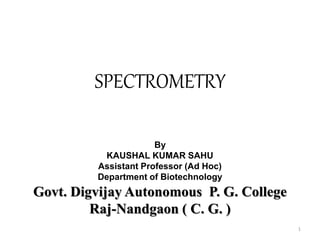Spectrometry by kk sahu sir
•Download as PPTX, PDF•
1 like•119 views
Introduction Properties of electromagnetic radiation The electromagnetic spectrum & its usage for spectroscopic method UV visible spectrometry Principle Device and mechanism Applications Mass spectrometry Parts of mass spectrometer Theoretical example Creating ions IR spectrometry Theory Vibrational modes Raman spectrometry Theory Applications References
Report
Share
Report
Share

Recommended
Recommended
More Related Content
What's hot
What's hot (20)
Introduction and principle of ir spectrophotometry

Introduction and principle of ir spectrophotometry
Similar to Spectrometry by kk sahu sir
Similar to Spectrometry by kk sahu sir (20)
principle, application and instrumentation of UV- visible Spectrophotometer 

principle, application and instrumentation of UV- visible Spectrophotometer
More from KAUSHAL SAHU
More from KAUSHAL SAHU (20)
Recently uploaded
Recently uploaded (20)
Biogenic Sulfur Gases as Biosignatures on Temperate Sub-Neptune Waterworlds

Biogenic Sulfur Gases as Biosignatures on Temperate Sub-Neptune Waterworlds
TransientOffsetin14CAftertheCarringtonEventRecordedbyPolarTreeRings

TransientOffsetin14CAftertheCarringtonEventRecordedbyPolarTreeRings
FAIRSpectra - Enabling the FAIRification of Spectroscopy and Spectrometry

FAIRSpectra - Enabling the FAIRification of Spectroscopy and Spectrometry
Porella : features, morphology, anatomy, reproduction etc.

Porella : features, morphology, anatomy, reproduction etc.
PATNA CALL GIRLS 8617370543 LOW PRICE ESCORT SERVICE

PATNA CALL GIRLS 8617370543 LOW PRICE ESCORT SERVICE
Role of AI in seed science Predictive modelling and Beyond.pptx

Role of AI in seed science Predictive modelling and Beyond.pptx
Cyathodium bryophyte: morphology, anatomy, reproduction etc.

Cyathodium bryophyte: morphology, anatomy, reproduction etc.
Site specific recombination and transposition.........pdf

Site specific recombination and transposition.........pdf
Use of mutants in understanding seedling development.pptx

Use of mutants in understanding seedling development.pptx
Bhiwandi Bhiwandi ❤CALL GIRL 7870993772 ❤CALL GIRLS ESCORT SERVICE In Bhiwan...

Bhiwandi Bhiwandi ❤CALL GIRL 7870993772 ❤CALL GIRLS ESCORT SERVICE In Bhiwan...
Spectrometry by kk sahu sir
- 1. SPECTROMETRY 1 By KAUSHAL KUMAR SAHU Assistant Professor (Ad Hoc) Department of Biotechnology Govt. Digvijay Autonomous P. G. College Raj-Nandgaon ( C. G. )
- 2. Synopsis • Introduction • Properties of electromagnetic radiation • The electromagnetic spectrum & its usage for spectroscopic method • UV visible spectrometry Principle Device and mechanism Applications • Mass spectrometry Parts of mass spectrometer Theoretical example Creating ions • IR spectrometry Theory Vibrational modes • Raman spectrometry Theory Applications • References 2
- 3. Introduction • Every chemical compound absorbs, transmits, or reflects light (electromagnetic radiation) over a certain range of wavelength. • Spectrometry is a measurement of how much a chemical substance absorbs or transmits. • Spectrometry is widely used for quantitative analysis in various areas (e.g., chemistry, physics, biology, biochemistry, material and chemical engineering, clinical applications, industrial applications, etc). 3
- 4. Properties of electromagnetic radiation 4
- 5. The electromagnetic spectrum and its usage for spectroscopic method 5
- 6. UV visible spectrometry • Ultraviolet-visible spectrometry (UV-Vis or UV/Vis) refers to absorption spectroscopy in the ultraviolet-visible spectral region. • It uses light in the visible and adjacent ranges. The absorption or reflectance in the visible range directly affects the perceived color of the chemicals involved. 6
- 9. Beer-Lambert Law We can determine the unknown concentration of the sample by using Beer-Lambert Law. Beer's Law is written as A = ϵlc • A is the measure of absorbance (no units), • ϵ is the molar extinction coefficient or molar absorptivity (or absorption coefficient), • l is the path length, and • c is the concentration. 9
- 10. Applications of Ultraviolet – visible spectroscopy • To determine concentration • To identify unknown compound • To asses quality of sample 10
- 11. max ( maximum absorbance (in nm) 11
- 12. If we know the optical density of following bio-molecules we can easily calculate the concentration of these molecules which are shown in below table. 12
- 13. Mass spectroscopy • The mass spectrometer is an instrument that used to calculate the mass of molecule. • A mass spectrometer consists of three components: an ion source, a mass analyzer, and a detector. • The ionizer converts a portion of the sample into ions. (MALDI, ESI, FAB). 13
- 14. basic structure of mass spectrometer 14
- 15. Infrared spectroscopy IR spectroscopy is a technique that uses infrared electromagnetic radiation to determine the functional groups that are present in molecules. 15
- 16. The infrared portion of the electromagnetic spectrum is usually divided into three regions; the near-, mid- and far- infrared 16
- 17. Theory • Just as electron can gain energy and transition to excited states molecules can also transition to higher energy level if they gain energy in just the right amount. • The bonds in molecules can be imagined to vibrate with a certain frequency and energy that is specific to that bond, just like masses vibrate on springs. 17
- 19. Number of vibrational modes 19
- 20. By using the table and graph determine which molecule closely match the data 20
- 21. Raman spectrometry • Raman spectroscopy named after Indian physicist Sir C. V. Raman) is a spectroscopic technique used to observe vibrational, rotational, and other low-frequency modes in a system. • Raman spectroscopy is commonly used in chemistry to provide a structural fingerprint by which molecules can be identified. 21
- 22. Theory 22
- 23. References • K. Wilson and J. Walker: principle and techniques of biotechnology and molecular biotechnology. Seventh Edition. • Spectrophotometry - Chemistry LibreTexts. • Instrumental methods of chemical analysis (Analytical Chemistry) By Dr. B. K. Sharma. 23
